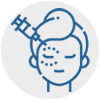Explore this page:

Botox Treatment – Overview
Botox® is the first and only Health Canada approved prescription medicine for treating chronic migraine headaches. Scientific studies and our experience confirm that Botox® injections relieve both the frequency and severity of chronic migraine headaches. Botox® injections are used to prevent headaches in adults (18 or older) with chronic migraines that occur more than 15 days a month, lasting 4 hours or more. On average, Botox prevents eight to nine headache and migraine days a month.
Botox Treatment for Chronic Migraine
Headache, Migraine & Concussion Centre offers Botox® treatment for chronic migraine headaches, a debilitating condition which affects approximately 2.7 million Canadians (or over 8% of the population).
Botox® has been approved for medical use since 2012. If you are over the age of 18 years and have recurring migraine headaches that last at least 4 hours on at least 15 days each month — defined as chronic migraine — you could benefit from preventive Botox® treatment that reduces the frequency and severity of migraine headaches.
What is Botox?
Botox treatment for Migraine involves injections of one of the forms of botulinum toxin, which is a protein produced by the bacterium Clostridium botulinum and species related to it. In turn, this toxin blocks signal transmission from nerves to muscles, resulting in muscle relaxation.
Botox® treatment for Migraine helps to decrease the severity of migraine symptoms such as pain, light and sound sensitivity, and nausea and vomiting. It can also reduce the number of headaches you experience each month.
How is a Botox injection Performed?
A Botox® injection is done in the office and takes the same amount of time as a regular medical visit. For migraine treatment, the doctor will administer 31 Botox® injections in 7 targeted areas of the head and neck muscles, including the nose, nose bridge, forehead, temples, the back of the head, as well as the neck and upper back. These locations are chosen to target the nerves which cause headache pain. In turn, Botox® enters the nerves and blocks pain signals from activation.
The injection process is relatively painless. Some patients describe the sensation as “tiny pinpricks.” If necessary, topical anesthesia can be used at the injection site before Botox® is administered.
What conditions can be treated with Botox® injections?
Botox® injections can be used to treat chronic migraine headaches, neck spasms (cervical dystonia), overactive bladder, excessive sweating, uncontrollable blinking, and lazy eye. We offer Botox® treatments to our patients who experience chronic migraines.
This condition is defined as having at least 15 headache days each month, at least eight of which include features specific to migraines, such as sensory sensitivities, nausea, or vomiting.
According to research published in the journal Neurology, only about one in three migraine patients takes advantage of preventive treatments despite the efficacy of this type of therapy.
How Effective Is Botox Treatment for Chronic Migraine?
On average, Botox® injection therapy for migraines can eliminate up to 9 or more headache days each month. The results last up to 12 weeks before another round of treatment is required. Since the effects of the treatment can develop gradually, some patients may not experience the optimal reduction in headaches until after 2 or 3 appointments.
In a clinical trial published in Johns Hopkins Advanced Studies in Medicine, patients reported 50% fewer headaches after 2 Botox® treatments. However, many patients experience relief within 5 to 14 days.
Botox® treatment helps to decrease the severity of migraine symptoms such as pain, light and sound sensitivity, and nausea and vomiting. It can also reduce the number of headaches you experience each month.
In most cases, Botox® for migraines can safely be used with other headache medications, including those taken to relieve pain or reduce symptoms at the onset of a headache. Preventive treatments can be effective in reducing the incidence of headaches exacerbated by overuse of pain medication. Patients who have fewer than 15 headache days each month are not eligible for Botox® treatment.
When performed by an experienced physician, Botox® injections are a safe way to treat chronic headaches. Potential side effects of this treatment may include pain or swelling at the injection site and flu-like symptoms. However, these side effects are rare, and most experts agree that this is a risk-free way to treat chronic migraine pain. Soreness after the procedure can be treated with an ice application to the affected area.
If you experience chronic migraine headaches, you can contact our experts at Headache, Migraine and Concussion Centre for a consultation. Our doctors will develop a thorough treatment plan to help relieve your painful symptoms to improve your quality of life.
We can help determine the cause of your headaches and identify underlying conditions that may contribute to chronic migraines. Call us to schedule your appointment at 905-477-4677.
References:
BOTOX® may cause serious side effects that can be life-threatening. Get medical help right away if you have any of these problems any time (hours to weeks) after injection of BOTOX®.
Problems swallowing, speaking or breathing due to weakening of associated muscles, can be severe and life-threatening. You are at the highest risk if you have a pre-existing medical history of similar health issues prior to BOTOX® injection. Swallowing problems may last for several months. Spread of toxin may affect areas away from the injection site and cause serious symptoms, including: loss of strength and all-over muscle weakness, double vision, blurred vision and drooping eyelids, hoarseness or change or loss of voice, trouble saying words clearly, loss of bladder control, trouble breathing, trouble swallowing.
There has not been a confirmed serious case of spread of toxin effect away from the injection site when BOTOX® was used at the recommended dose to treat chronic migraine. BOTOX® may cause loss of strength or general muscle weakness, vision problems, or dizziness within hours to weeks of taking BOTOX®. If you experience any of these symptoms, do not drive a car, operate machinery, or do other dangerous activities.
Do not take BOTOX® if you: are allergic to any of the ingredients in BOTOX® (see Medication Guide for ingredients); had an allergic reaction to any other botulinum toxin product such as Myobloc® (rimabotulinumtoxinB), Dysport® (abobotulinumtoxinA), or Xeomin® (incobotulinumtoxinA); have a skin infection at the planned injection site.
The dose of BOTOX® is not the same as, or comparable to, another botulinum toxin product: Serious and/or immediate allergic reactions have been reported. They include itching, rash, red itchy welts, wheezing, asthma symptoms, or dizziness or feeling faint. Get medical help right away if you experience symptoms; further injection of BOTOX® should be discontinued.
Tell your doctor about all your muscle or nerve conditions such as ALS or Lou Gehrig’s disease, myasthenia gravis, or Lambert-Eaton syndrome, as you may be at increased risk of serious side effects including difficulty swallowing and difficulty breathing from typical doses of BOTOX®. Tell your doctor about all of your medical conditions (past and present), including: bleeding problems; plans to have surgery; previous surgery on your face; weakness of forehead muscles; trouble raising your eyebrows; drooping eyelids; any other abnormal facial change; are pregnant or plan to become pregnant (it is not known if BOTOX® can harm your unborn baby); are breastfeeding or plan to (it is not known if BOTOX® passes into breast milk).
Tell your doctor if you have received any other botulinum toxin product in the last 4 months; have received injections of botulinum toxin such as Myobloc®, Dysport‘fi’, or Xeomin® in the past (tell your doctor exactly which product you received); have recently received an antibiotic by injection; take muscle relaxants; take an allergy or cold medicine; take a sleep medicine; take aspirin-Iike products or blood thinners.
Other side effects of BOTOX® include: dry mouth, discomfort or pain at the injection site, tiredness, headache, neck pain, and eye problems: double vision, blurred vision, decreased eyesight, drooping eyelids, swelling of your eyelids, and dry eyes.
For more information, please refer to the Medication Guide or talk with your doctor. You are encouraged to report negative side effects of prescription drugs to the FDA. Visit www.fda.gov/medwatch or call 1-800-FDA-1088.
Indications
BOTOX® is a prescription medicine that is injected to prevent headaches in adults with chronic migraine who have 15 or more days each month with headache lasting 4 or more hours each day in individuals aged 18 years or older.
It is not known whether BOTOX® is safe or effective to prevent headaches in patients with migraine who have 14 or fewer headache days each month (episodic migraine).
Please see BOTOX® full Product Information including Boxed Warning and Medication Guide.
Frequently Asked Questions
BOTOX® Treatment for Migraines
BOTOX® is the first Health Canada approved and FDA approved preventive treatment for chronic migraine. Unlike acute treatments, which are taken to treat a headache or migraine once it’s already begun, BOTOX® treatment prevents headaches and migraines before they even start.
BOTOX® prevents on average 8 to 9 headache days and migraine/probable migraine days a month (compared to 6 to 7 for placebo).
5 things you should know about BOTOX® treatment
Chronic migraine is a neurological condition that is defined by having 15 or more headache days per month, with each headache lasting 4 hours or more, and 8 of those days associated with a migraine.
Frequent or re-occurring migraines may often be referred to as chronic, or “chronic migraines.” However, chronic migraine is defined as a medical condition that involves 15 or more headache days per month, with each headache lasting 4 hours or more, and 8 of those days associated with migraine.
According to Statistics Canada, an estimated 8.3% of Canadians (2.7 million) reported that they had been diagnosed with migraine. However, research also indicates that this likely underestimates the true number of people in Canada living with migraine pain, since some people who experience migraines do not seek professional help.
The difference between an episodic migraine (EM) and chronic migraine (CM) is how frequently the migraines occur. Your doctor may diagnose you with episodic migraine if you have fewer than 14 headache days per month for 3 months. Chronic migraine is a more debilitating condition, where individuals experience 15 headache days or more per month. Often, episodic migraines progress into chronic migraines. If you your migraines occur weeks or months apart from each other, they can be classified as episodic migraine.
There are several effective treatment options for chronic migraine. Our team of experts at the HMC Centre are specialists in treatment of chronic migraine headaches. We will develop a comprehensive treatment plan to help you recover from headache migraine pain so you can start living again.
There are several effective treatment options for chronic migraine. Our team of experts at the HMC Centre are specialists in treatment of chronic migraine headaches. We will develop a comprehensive treatment plan to help you recover from headache migraine pain so you can start living again.
BOTOX® For Migraines
BOTOX® is part of a group of drugs known as biologics, which are made from living organisms or contain components of living organisms. BOTOX® is a purified protein that is made from a type of bacteria called Clostridium botulinum type A.
This treatment can be used to prevent headaches in adults with Chronic Migraine who have 15 or more headache days each month with headache lasting 4 hours or more each day in individuals aged 18 years or older.
lt is currently not known whether BOTOX® is safe or effective when used to prevent headaches in patients with migraine who have 14 or fewer headache days each month (episodic migraine). ln clinical trials, BOTOX® provided a significant reduction in headache days after the first treatment. After the second treatment (at 24 weeks), BOTOX® prevented 8 to 9 headache days a month (compared to 6 to 7 for placebo). You may start to feel results as early as at 4 weeks following treatment. Over the course of 2 treatment sessions, you should notice a reduction in headache days you typically experience.
The needle used to inject BOTOX® is half an inch long and very thin. The injections take about 15 minutes, and though you may experience mild discomfort, many people who undergo this treatment say the injection feel like pinches or pinpricks.
BOTOX® injections are typically given every 12 weeks by your doctor. For 2 treatments (at 24 weeks), BOTOX® was proven to reduce headache days each month vs. placebo. ln clinical studies, BOTOX® prevented on average 8-9 headache days a month (compared to 6-7 for placebo). Based on your progress, you and your doctor will discuss re-treatment every 12 weeks.
In clinical trials, BOTOX® provided a significant reduction in headache days after the first treatment. After the second treatment (at 24 weeks), BOTOX® prevented up to 8-9 headache days a month (compared to 6-7 for placebo). You may start to feel results as early as at 4 weeks following treatment. Over the course of 2 treatment sessions, you should notice a reduction in the number of headache days you typically experience.
If your doctor recommends it, you may still take acute medications while you are on BOTOX® treatment. BOTOX® is a preventive treatment, which means it works to prevent headache days. Acute treatments, on the other hand, are taken to reduce pain once a headache or migraine has already begun.
The injection sites used to administer BOTOX® for chronic migraine are specifically designed to help prevent headaches and migraines. BOTOX® treatment is for adults aged 18 years and older with chronic migraine of 15 or more headache days a month, each lasting 4 hours or more. BOTOX® therapy is not approved for adults with migraine who have 14 or fewer headache days a month.
Headache, Migraine and Concussion Centre has physicians with at least 10 years of injecting experience using BOTOX® for prevention of migraines.
Most insurance plans cover most of the cost of BOTOX® treatment.
BOTOX® may cause serious side effects that can be life-threatening. Get medical help right away if you have any of these problems any time (hours to weeks) after injection of BOTOX®:
Problems swallowing, speaking or breathing due to weakening of associated muscles, can be severe and life-threatening. You are at the highest risk if you have a pre-existing medical history of similar health issues prior to BOTOX® injection. Swallowing problems may last for several months.
Spread of toxin may affect areas away from the injection site and cause serious symptoms, including: loss of strength and all-over muscle weakness, double vision, blurred vision and drooping eyelids, hoarseness or change or loss of voice, trouble saying words clearly, loss of bladder control, trouble breathing, trouble swallowing.
There has not been a confirmed serious case of spread of toxin effect away from the injection site when BOTOX® was used at the recommended dose to treat chronic migraine.
BOTOX® may cause loss of strength or general muscle weakness, vision problems, or dizziness within hours to weeks of taking BOTOX®. If you experience any of these symptoms, do not drive a car, operate machinery, or do other dangerous activities.
Do not take BOTOX® if you: are allergic to any of the ingredients in BOTOX® (see Medication Guide for ingredients); had an allergic reaction to any other botulinum toxin product such as Myobloc® (rimabotulinumtoxinB), Dysport® (abobotulinumtoxinA), or Xeomin® (incobotulinumtoxinA); have a skin infection at the planned injection site.
The dose of BOTOX® is not the same as, or comparable to, another botulinum toxin product:
Serious and/or immediate allergic reactions have been reported. They include itching, rash, red itchy welts, wheezing, asthma symptoms, or dizziness or feeling faint. Get medical help right away if you experience symptoms; further injection of BOTOX® should be discontinued.
Tell your doctor about all your muscle or nerve conditions such as ALS or Lou Gehrig’s disease, myasthenia gravis, or Lambert-Eaton syndrome, as you may be at increased risk of serious side effects including difficulty swallowing and difficulty breathing from typical doses of BOTOX®.
Tell your doctor about all of your medical conditions (past and present), including: bleeding problems; plans to have surgery; previous surgery on your face; weakness of forehead muscles; trouble raising your eyebrows; drooping eyelids; any other abnormal facial change; are pregnant or plan to become pregnant (it is not known if BOTOX® can harm your unborn baby); are breastfeeding or plan to (it is not known if BOTOX® passes into breast milk).
Tell your doctor about any medications you take, including prescription and non-prescription medicines, vitamins, and herbal products. Using BOTOX® certain other medicines may cause serious side effects. Do not start any new medicines until you have told your doctor that you have received BOTOX® in the past.
Tell your doctor if you have received any other botulinum toxin product in the last 4 months; have received injections of botulinum toxin such as Myobloc®, Dysport‘fi’, or Xeomin® in the past (tell your doctor exactly which product you received); have recently received an antibiotic by injection; take muscle relaxants; take an allergy or cold medicine; take a sleep medicine; take aspirin-Iike products or blood thinners.
Other side effects of BOTOX® include: dry mouth, discomfort or pain at the injection site, tiredness, headache, neck pain, and eye problems: double vision, blurred vision, decreased eyesight, drooping eyelids, swelling of your eyelids, and dry eyes.
For more information, please refer to the Medication Guide or talk with your doctor.
You are encouraged to report negative side effects of prescription drugs to the FDA. Visit www.fda.gov/medwatch or call 1-800-FDA-1088.
Indications
BOTOX® is a prescription medicine that is injected to prevent headaches in adults with chronic migraine who have 15 or more days each month with headache lasting 4 or more hours each day in individuals aged 18 years or older.
It is not known whether BOTOX® is safe or effective to prevent headaches in patients with migraine who have 14 or fewer headache days each month (episodic migraine).
Please see BOTOX® full Product Information including Boxed Warning and Medication Guide.






